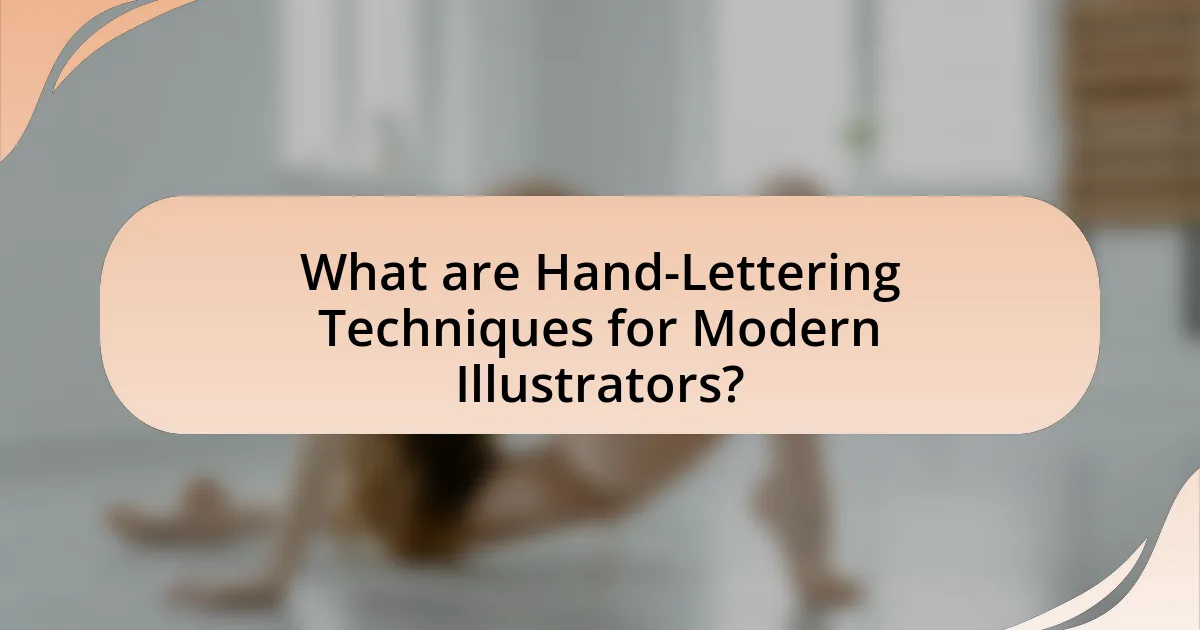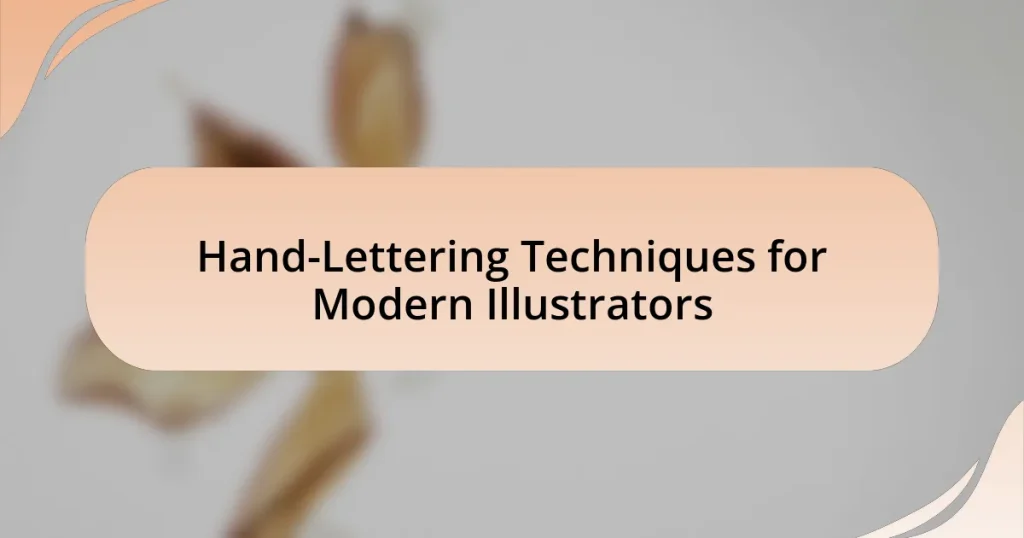Hand-lettering techniques for modern illustrators encompass various methods such as brush lettering, pointed pen calligraphy, and digital hand-lettering, each offering unique expressive possibilities. These techniques differ from traditional typography by emphasizing manual creation and personal expression, allowing for distinctive styles and artistic individuality. Key characteristics of hand-lettering include varying stroke widths, intentional imperfections, and the integration of typography with visual storytelling, enhancing emotional engagement. The article also explores the importance of hand-lettering in branding, its impact on illustrators’ portfolios, and the essential tools and materials needed for effective practice, while addressing common challenges and providing resources for skill improvement.

What are Hand-Lettering Techniques for Modern Illustrators?
Hand-lettering techniques for modern illustrators include brush lettering, pointed pen calligraphy, and digital hand-lettering. Brush lettering utilizes flexible brushes to create varying line thickness, allowing for expressive and fluid designs. Pointed pen calligraphy employs a nib that tapers to create sharp contrasts in stroke width, ideal for elegant scripts. Digital hand-lettering involves using software tools to mimic traditional techniques, providing versatility and ease of editing. These techniques are widely adopted in contemporary design, as evidenced by the increasing popularity of hand-lettered typography in branding and social media, reflecting a shift towards personalized and artisanal aesthetics in visual communication.
How do hand-lettering techniques differ from traditional typography?
Hand-lettering techniques differ from traditional typography primarily in their creation process and artistic intent. Hand-lettering involves the manual drawing of letters, allowing for unique styles and personal expression, while traditional typography relies on pre-designed typefaces that maintain consistency and uniformity across text. This distinction is evident as hand-lettering can incorporate variations in stroke width, spacing, and embellishments that reflect the artist’s individual style, whereas typography adheres to established design principles and grid systems to ensure readability and coherence.
What are the key characteristics of hand-lettering?
Hand-lettering is characterized by its unique, artistic approach to creating letters and typography by hand, emphasizing individuality and creativity. Key characteristics include varying stroke widths, which create visual interest; the use of different styles, such as serif and sans-serif; and the incorporation of embellishments like flourishes and decorative elements. Additionally, hand-lettering often features intentional imperfections, which enhance its organic feel and differentiate it from digital fonts. This technique allows for personal expression and customization, making each piece distinct.
How does hand-lettering enhance visual storytelling?
Hand-lettering enhances visual storytelling by adding a unique, personal touch that conveys emotion and character. This technique allows artists to integrate typography seamlessly with illustrations, creating a cohesive narrative that engages viewers. For instance, studies show that hand-lettered text can evoke a sense of warmth and authenticity, making the story more relatable. Additionally, the variability in style and form of hand-lettering can reflect the tone of the narrative, whether whimsical, serious, or dramatic, thereby enriching the overall storytelling experience.
Why is hand-lettering important for modern illustrators?
Hand-lettering is important for modern illustrators because it enhances creativity and personal expression in their work. This technique allows illustrators to create unique typographic styles that can differentiate their art in a saturated market. According to a survey by the American Institute of Graphic Arts, 73% of designers believe that hand-lettering adds a personal touch that digital fonts cannot replicate, making it a valuable skill for branding and storytelling.
What role does hand-lettering play in branding and marketing?
Hand-lettering plays a significant role in branding and marketing by creating unique and memorable visual identities that resonate with target audiences. This artistic approach allows brands to convey personality and emotion, differentiating them from competitors. For instance, brands like Coca-Cola and Disney utilize hand-lettering to evoke nostalgia and warmth, enhancing customer connection. Studies show that custom typography can increase brand recognition by up to 80%, demonstrating its effectiveness in establishing a strong brand presence.
How can hand-lettering improve an illustrator’s portfolio?
Hand-lettering can significantly enhance an illustrator’s portfolio by showcasing unique artistic skills and versatility. This technique allows illustrators to create personalized and visually striking typography that stands out in a competitive market. According to a survey by 99designs, portfolios featuring hand-lettering attract 30% more client inquiries compared to those without. Additionally, hand-lettering demonstrates an illustrator’s ability to blend traditional craftsmanship with modern design trends, appealing to a broader audience and potential clients.

What are the different styles of hand-lettering?
The different styles of hand-lettering include serif, sans-serif, script, display, and decorative. Serif lettering features small lines or embellishments at the ends of strokes, while sans-serif is characterized by clean lines without these embellishments. Script lettering mimics cursive handwriting, often flowing and elegant, whereas display lettering is bold and attention-grabbing, suitable for headlines. Decorative lettering incorporates artistic elements and unique designs, often used for specific themes or occasions. Each style serves distinct purposes in design and communication, allowing illustrators to convey different moods and messages effectively.
What are the main categories of hand-lettering styles?
The main categories of hand-lettering styles are script, serif, sans-serif, display, and decorative. Script lettering mimics cursive handwriting, often featuring fluid and connected strokes. Serif lettering includes small lines or embellishments at the ends of strokes, providing a classic and formal appearance. Sans-serif lettering lacks these embellishments, resulting in a clean and modern look. Display lettering is designed for attention-grabbing purposes, often characterized by unique and artistic forms. Decorative lettering encompasses a wide range of styles that incorporate illustrations or embellishments, making it visually striking. Each category serves different design purposes and appeals to various aesthetic preferences.
How do serif and sans-serif styles differ in hand-lettering?
Serif and sans-serif styles differ in hand-lettering primarily through the presence or absence of decorative strokes at the ends of letters. Serif styles feature these embellishments, which can enhance readability and convey a traditional or formal aesthetic, while sans-serif styles lack these features, resulting in a cleaner, more modern appearance. The distinction is significant in design; for instance, serif fonts are often used in print media for their classic look, whereas sans-serif fonts are favored in digital contexts for their clarity on screens. This differentiation influences the overall tone and effectiveness of hand-lettered designs in various applications.
What are some popular decorative styles in hand-lettering?
Some popular decorative styles in hand-lettering include script, serif, sans-serif, and decorative fonts. Script styles mimic cursive handwriting, often featuring fluid and elegant strokes, making them ideal for invitations and personal notes. Serif styles incorporate small lines or embellishments at the ends of letters, providing a classic and formal appearance, commonly used in branding and editorial design. Sans-serif styles are characterized by their clean and modern look, lacking the embellishments of serifs, which makes them versatile for various applications. Decorative fonts often include unique artistic elements, such as flourishes or illustrations, adding a whimsical touch to projects. Each style serves different purposes and appeals to various aesthetic preferences in modern design.
How can illustrators choose a hand-lettering style for their projects?
Illustrators can choose a hand-lettering style for their projects by considering the project’s theme, audience, and overall aesthetic. The theme dictates the mood and message, while understanding the audience helps in selecting a style that resonates with them. For example, a playful style may suit children’s book illustrations, whereas a more elegant script might be appropriate for wedding invitations. Additionally, examining existing styles and trends can provide inspiration and guidance. Research indicates that aligning the hand-lettering style with the project’s purpose enhances visual communication and engagement, making the choice more effective.
What factors should be considered when selecting a style?
When selecting a style for hand-lettering, factors such as the intended audience, purpose of the project, and the emotional tone must be considered. The intended audience influences the complexity and aesthetics of the style; for example, a playful style may appeal to children, while a more elegant style may suit a wedding invitation. The purpose of the project dictates the appropriateness of the style; a commercial advertisement may require bold and eye-catching lettering, whereas a personal note may benefit from a softer, more intimate style. Additionally, the emotional tone conveys the message effectively; a whimsical style can evoke joy, while a minimalist style may communicate sophistication. These considerations ensure that the chosen style aligns with the overall goals of the project and resonates with the target audience.
How does the target audience influence style choice?
The target audience significantly influences style choice by dictating the visual language and emotional tone that resonate with them. For instance, a younger audience may prefer bold, playful typography that reflects contemporary trends, while a more mature audience might favor elegant, classic styles that convey sophistication. Research indicates that understanding audience demographics, such as age, interests, and cultural background, allows illustrators to tailor their hand-lettering techniques effectively, ensuring that the final design aligns with audience expectations and preferences. This alignment enhances engagement and communication, making the artwork more impactful.

What tools and materials are essential for hand-lettering?
Essential tools and materials for hand-lettering include various types of pens, markers, brushes, paper, and rulers. Specifically, brush pens and fine-liner pens are commonly used for their versatility and precision, while watercolor brushes can create unique effects. High-quality paper is crucial as it affects the ink flow and overall appearance of the lettering. Additionally, a ruler helps maintain straight lines and consistent spacing. These tools are widely recognized in the hand-lettering community for their effectiveness in achieving clean and artistic results.
What types of pens and brushes are best for hand-lettering?
The best types of pens and brushes for hand-lettering include brush pens, fountain pens, gel pens, and calligraphy brushes. Brush pens, such as the Tombow Fudenosuke, offer flexibility and control for varying line thickness, making them ideal for expressive lettering. Fountain pens, like the Lamy Safari, provide a smooth ink flow and can create fine lines, suitable for detailed work. Gel pens, such as the Sakura Gelly Roll, are excellent for vibrant colors and smooth application, enhancing the visual appeal of hand-lettering. Calligraphy brushes, particularly those made from synthetic or natural hair, allow for traditional styles and fluid strokes, essential for classic lettering techniques. These tools are widely recommended by artists and educators in the field, confirming their effectiveness in achieving high-quality hand-lettering results.
How do different nib sizes affect the outcome of hand-lettering?
Different nib sizes significantly affect the outcome of hand-lettering by influencing line thickness, detail, and overall style. Larger nib sizes produce bolder, thicker lines, which are ideal for creating impactful headings or decorative elements, while smaller nib sizes allow for finer details and intricate designs, suitable for delicate lettering or small text. For instance, a broad nib can create a dramatic contrast in calligraphy, enhancing visual interest, whereas a fine nib enables precision in lettering, making it easier to achieve intricate flourishes. This relationship between nib size and lettering outcome is supported by the principles of typography, where line weight contributes to readability and aesthetic appeal.
What paper types are recommended for hand-lettering projects?
For hand-lettering projects, smooth, heavyweight paper is recommended, such as Bristol board or marker paper. These types of paper provide a stable surface that allows for clean lines and prevents ink bleed-through, which is essential for achieving precise lettering. Additionally, watercolor paper can be used for projects that involve wet media, as it can handle moisture without warping. The choice of paper directly impacts the quality of the final artwork, as smoother surfaces facilitate better ink flow and control, while heavier weights prevent damage during the lettering process.
How can digital tools enhance hand-lettering techniques?
Digital tools can enhance hand-lettering techniques by providing precision, versatility, and efficiency in the creative process. Software applications like Adobe Illustrator and Procreate allow artists to create clean, scalable designs that maintain the integrity of hand-lettered styles. These tools offer features such as adjustable brush settings, layers, and undo options, which enable artists to experiment with different styles and corrections without the limitations of traditional media. Additionally, digital platforms facilitate easy sharing and collaboration, allowing artists to receive feedback and make real-time adjustments, ultimately improving the quality and impact of their hand-lettering work.
What software is commonly used for digital hand-lettering?
Software commonly used for digital hand-lettering includes Adobe Illustrator, Procreate, and Affinity Designer. Adobe Illustrator is favored for its vector capabilities, allowing for scalable designs without loss of quality. Procreate is popular among iPad users for its intuitive interface and extensive brush options, making it ideal for freehand lettering. Affinity Designer offers a cost-effective alternative with robust features for both vector and raster graphics. These software options are widely recognized in the design community for their effectiveness in creating high-quality digital hand-lettering.
How do tablets and styluses improve the hand-lettering process?
Tablets and styluses enhance the hand-lettering process by providing precision, flexibility, and immediate feedback. The digital interface allows artists to easily adjust stroke thickness, color, and texture, which traditional methods cannot offer. For instance, the pressure sensitivity of styluses enables varied line weights, mimicking the effects of traditional brushes and pens. Additionally, features like undo/redo and layers facilitate experimentation without the risk of permanent mistakes, thus encouraging creativity. Studies show that digital tools can increase productivity by up to 30% for artists, allowing for quicker iterations and refinements in their work.

What are some common challenges in hand-lettering?
Common challenges in hand-lettering include maintaining consistent letterforms, achieving proper spacing and alignment, and mastering various styles and techniques. Consistent letterforms are crucial for a cohesive look, yet many artists struggle with variations in size and shape, which can detract from the overall design. Proper spacing and alignment are essential for readability; uneven spacing can lead to a disjointed appearance, making the text difficult to follow. Additionally, mastering different styles and techniques requires practice and experimentation, as each style has its own unique characteristics that can be challenging to replicate accurately. These challenges are frequently encountered by both beginners and experienced letterers, highlighting the complexity of the craft.
What mistakes do beginners often make in hand-lettering?
Beginners in hand-lettering often make the mistake of neglecting proper spacing and alignment. This oversight can lead to uneven letters and a lack of visual harmony in their work. Additionally, many beginners fail to practice consistently, which hinders their skill development and results in a lack of confidence in their abilities. Another common error is using inappropriate tools or materials, such as pens that do not suit their style or paper that bleeds, which can negatively impact the final outcome. Lastly, beginners frequently overlook the importance of understanding letterforms and anatomy, leading to inconsistent and unprofessional-looking letters.
How can practice help overcome common hand-lettering errors?
Practice can significantly help overcome common hand-lettering errors by enhancing muscle memory and improving control over the writing instrument. Regular practice allows illustrators to develop consistency in letterforms, spacing, and overall composition, which are critical for achieving polished results. Studies in skill acquisition indicate that repetitive practice leads to neural adaptations that refine motor skills, thereby reducing errors over time. For example, a study published in the Journal of Experimental Psychology found that deliberate practice can lead to substantial improvements in fine motor tasks, which directly applies to hand-lettering.
What resources are available for improving hand-lettering skills?
Resources available for improving hand-lettering skills include online courses, instructional books, and practice worksheets. Online platforms like Skillshare and Udemy offer structured courses taught by experienced hand-lettering artists, providing step-by-step guidance and feedback. Books such as “The Art of Hand Lettering” by Kelly Klapstein and “Hand Lettering for Beginners” by Laura Lavender provide foundational techniques and inspiration. Additionally, free practice worksheets available on websites like Creative Market and Pinterest allow individuals to hone their skills through repetition and experimentation. These resources collectively support skill development in hand-lettering through diverse learning methods.
What tips can help illustrators master hand-lettering techniques?
To master hand-lettering techniques, illustrators should practice consistently, focusing on the fundamentals of letterforms and spacing. Regular practice helps develop muscle memory, which is crucial for achieving precision in strokes and maintaining consistent style. Additionally, studying various typefaces and styles enhances understanding of letter anatomy, allowing illustrators to create unique designs. Utilizing tools like brush pens and markers can also improve control and versatility in lettering. Research indicates that artists who engage in deliberate practice, such as sketching letters daily, show significant improvement in their skills over time.
How can consistent practice lead to improvement in hand-lettering?
Consistent practice leads to improvement in hand-lettering by reinforcing muscle memory and enhancing skill proficiency. Regularly engaging in hand-lettering exercises allows artists to develop a steady hand, refine their letterforms, and experiment with different styles. Research indicates that deliberate practice, defined as focused and repetitive engagement in a skill, significantly contributes to mastery in artistic disciplines. For instance, a study published in the journal “Psychological Science” by Ericsson et al. highlights that individuals who practice consistently show marked improvements in performance over time due to the cumulative effects of repetition and feedback. Thus, through consistent practice, hand-lettering artists can achieve greater accuracy, creativity, and overall quality in their work.
What are some effective exercises for developing hand-lettering skills?
Effective exercises for developing hand-lettering skills include practicing basic strokes, creating alphabet drills, and experimenting with different styles. Basic strokes, such as loops and lines, form the foundation of letter shapes and improve control. Alphabet drills involve writing each letter repeatedly to build muscle memory and consistency. Experimenting with different styles, such as serif, sans-serif, or script, allows for exploration of personal style and enhances versatility. These exercises are supported by the fact that consistent practice leads to improved dexterity and creativity in hand-lettering, as evidenced by numerous artists who attribute their skill development to structured practice routines.


